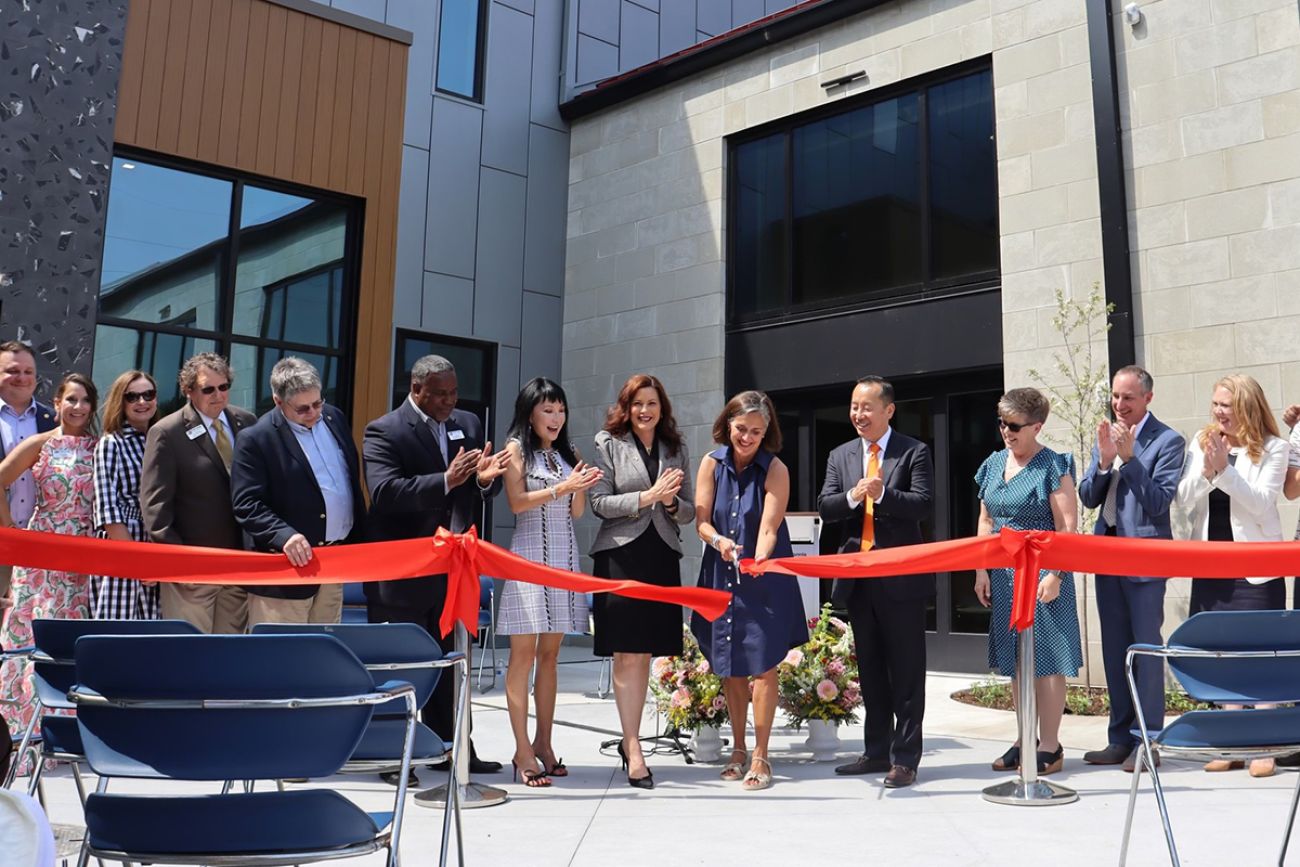Experts: Michigan lawmakers should make 6 fixes to improve senior care

- Michigan has been slower than some states to address the care needed for a growing population of senior citizens
- More money and less red tape would ease the burden on seniors and their families
- Michigan has increased programs that aid seniors, but more needs to be done, say advocates
It was all smiles at the 2022 ribbon cutting for a senior center in Portage, even as Gov. Gretchen Whitmer was blunt about a senior care crisis facing the state.
“We must do more to help older Michiganders access affordable healthcare, retire with dignity, and have attainable, affordable housing,” she said.

Three years later, the problem is more dire than ever. Older Michiganders struggle to qualify and find home care in a state where senior services are underfunded and difficult to navigate.
It doesn’t have to be this way.
Over three months, Bridge spoke to experts, legislators and leaders of senior service organizations. They offered six fixes for lawmakers to head off major problems before they get even worse in one of the most rapidly aging states in the nation.
Fix #1: Reduce red tape
Michigan seniors and their families must navigate a thicket of bureaucracy, complicated by differing eligibility levels and a maze of local and state providers.
For example: to qualify for the state’s senior citizen food program, you must be 60, but to get home-delivered meals through the state older Michigander program Mi Choice, you must be 65. The income limit to enroll in Mi Choice is $34,812, but for Medicaid, which is a key funding component of Mi Choice, it’s $18,000.
Even Scott Wamsley, director of the state’s Bureau of Aging, Community Living and Supports, told Bridge he struggles with the system when helping his parents sign up for benefits.
Wamsley listed reducing and simplifying the process of applying for services as his top priority.
“Is there a way to make sure … we don't have conflicting eligibility and conflicting ways to get into programs?” Wamsley asked. “One of the challenges is, and this is both federal and state, how do we ease the path of people into these programs, because differing rules, differing eligibility criteria, differing income levels and things like that, make it challenging for people to get what they need.”
We want to hear from you
Bridge Michigan is writing about issues surrounding older residents in a state aging faster than most others.
What are the challenges ahead for you as you age or help care for an aging loved one? What are the best programs out there? How has your life changed as you move from career to retirement or family home to assisted living? Or maybe you’ve got an idea to help bridge the gaps in housing, transportation, health care and other services for older Michiganders.
Drop us a line at rerb@bridgemi.com
Fix #2: Extend pay increase
Increasing funding for senior services only helps if there are enough direct care workers to perform care.
There are about 190,000 direct care workers in the state, with a shortage of an estimated 36,000 more.
Currently, in-home care workers get an additional $3.40 an hour from the state for their work, a pay supplement originally added during the pandemic with federal funding. That federal COVID money expires this fall.
Even with that supplement, in-home care providers average less than $17 an hour. That’s comparable to the hourly rate at McDonald’s in Traverse City for a job that requires, among other things, knowledge of CPR, infection control and the physical ability to move seniors around their homes.
Related:
- Where to find help for Michigan seniors. A guide for navigating the maze
- How to plan for aging in Michigan or take care of others: What to know
- Unlocking the secrets of Michigan’s ‘superagers,’ who defy golden years
- Whitmer proposes more money for Michigan's aging crisis. Is it enough?
- Crush of retirees a crisis in Michigan. State unprepared to meet their needs
- Watch Bridge Lunch Break on the challenges of aging in Michigan
“We have these agencies that want to pay better, but they can't charge the families much, because Medicaid isn’t paying well,” said Laura Haynes, president of the Michigan HomeCare and Hospice Association. “Finding people to do these jobs, going into the home and caring for seniors, is very difficult. So families end up putting their relatives in nursing homes.”
Nursing home care is at least 2.5 times more expensive for families — and state taxpayers, because Medicaid picks up the majority of the bills — than home care.
As long as there are similarly paid jobs, many of them less stressful and physically taxing than caring for the elderly, there will be a shortage of in-home care workers, Haynes said.
The answer, Haynes said, is higher pay, which would come from higher Medicaid reimbursements set by the state.
Fix #3: Better utilize existing workers
Ronald Taylor, president and CEO of the Detroit Area Agency on Aging, suggests using more community health workers, who are specially trained and hyper-local public health workers, to fill gaps in services.
In rural Oregon, Connected Care deploys community health workers to check on residents 55 and older and who are determined “frail” by a doctor.
Many live more than an hour from their doctors’ offices and are at risk of misunderstanding doctor’s directions or missing appointments, Dr. Elizabeth Foster, a long-time family physician and one of the program’s architects, told Bridge.
In the first two years of the program, 70 doctors in seven rural clinics enrolled 283 patients in the program. On average, the community health workers visited patients five times in their homes and talked to the patient by phone about seven times.
Specialists in finding resources and navigating bureaucracy, the community health workers knitted together transportation, sources of food, dental and vision care, home repair and other assistance for the patients.
The community health workers make about $25 an hour and are paid mileage. The program costs about $450,000 a year, but saves about $2.4 million, in part, by helping patients avoid medication mishaps and hospitalizations and filing their advanced directives, according to Connected Care estimates.
“Providers love it. Patients love it. Caregivers love it,” Foster said.
Fix #4: Reprioritize Meals on Wheels
Local service providers say they need more state money for Meals on Wheels, which advocates say offers great bang for the buck to keep seniors in less-expensive, more desired in-home care.
Currently, it’s common to have waiting lists to receive Meals on Wheels, and those getting food delivered to their home sometimes get fewer meals per week than agencies feel are needed.
In Michigan, Meals on Wheels programs are funded through a combination of federal funds (primarily through the Older Americans Act), state funding, local grants, private donations, and participant contributions.
In 2021, in Michigan, Meals on Wheels provided 10.7 million meals to 107,000 seniors. Just 47% of those seniors, though, received in-home meals – the rest were served in congregate settings like senior centers.
The program gets funding through a variety of federal, state and local sources. The state provides $3.5 million for senior nutrition services statewide.
Carl Buonodono, nutrition director at Tri County Office on Aging in Lansing, said there is a three to six-month waiting list to receive in-home meals in Eaton County, which his office serves.
And the agency sometimes makes the frustrating calculation to offer fewer meals to individual seniors than Buonodono would like.
“In Clinton County, we've been underserving some folks because we have a limited number of meals,” Buonodono said. “If somebody really needs 14 meals in a week, but if we add that 14 meals in (to our budget), it's going to throw us over our numbers, so we can do five or 10.
“It's better to get five to 10 (meals) to more people than none to some.”
The answer is more funding, he said.
“It’s like this statewide,” Buonodono said. “We're doing the best that we can to maximize what we have.”
Fix #5: Offer tax credits for caregivers
Six states — Montana, North Dakota, Missouri, Georgia, South Carolina and New Jersey — offer a tax credit to offset the costs of caregiving, which average $7,000 per family, according to an AARP study.
Last year, Whitmer sought to make Michigan the seventh, proposing a $5,000 tax credit for out-of-pocket expenses incurred by family caregivers.
The hope was that it could help keep some seniors out of nursing homes, where cost to the state is much higher than caring for the elderly at home.
The proposal was expected to cost the state about $37 million annually, but may have had wide impact: An estimated 1.7 million Michiganders help care for aging or disabled relatives, a figure that will increase as the share of Michigan residents age 65 and over grows.
The credit didn’t make it into the final budget negotiated by the governor, the House and Senate in 2024, and Whitmer didn’t include the credit in her most recent proposed state budget.
Any conversation about helping people age in place means supporting unpaid caregivers — loved ones, adult children and neighbors who make refrigerators are stocked, medications are filled and appointments met.
Supporting them is a boon to the economy, said Taylor of the Detroit Area Agency on Aging.
“Take a look to the impact that caregivers may have within the business community — as far as there's an economic engine behind that also related to lost productivity, the engagement from a team member that may just be tired from providing care,”
The Area Agencies on Aging Association of Michigan is launching a new website in June to support family caregivers.
Fix #6: Simplify nursing home funding
Michigan reimburses nursing homes for caring for seniors, but critics say it does so through a complicated formula that is weighted to the costs of running the entire building, rather than focusing on the level of need of the residents.
Michigan is just one of two states that used such a process — one laid out in a 66-page book of instructions, according to the Michigan Elder Justice Initiative, a Lansing-based advocacy group.
In 2019, Michigan’s auditor general concluded that the long-term care cost reimbursement is “complicated, labor-intensive, ineffective and inefficient.”
The policies create a “cat-and-mouse” game between nursing homes wanting to maximize reimbursements and the state trying to contain costs, said Mike Daeschlein, a long-term care policy expert at the initiative, and formerly with the Michigan Department of Health and Human Services.
It’s akin to paying each school based on what its staff says it costs to operate the building, rather than reimbursing the school based on the number of students who are being educated. Daeschlein and others say the complicated process further tilts Michigan’s long-term care funding toward nursing home care rather than aging-in-place efforts.
Rather, he says, the state should simplify its payment process and — most importantly — shift the calculations to focus on the acuity of care — the complexity and cost of needs — for its residents rather than building-wide costs.
See what new members are saying about why they donated to Bridge Michigan:
- “In order for this information to be accurate and unbiased it must be underwritten by its readers, not by special interests.” - Larry S.
- “Not many other media sources report on the topics Bridge does.” - Susan B.
- “Your journalism is outstanding and rare these days.” - Mark S.
If you want to ensure the future of nonpartisan, nonprofit Michigan journalism, please become a member today. You, too, will be asked why you donated and maybe we'll feature your quote next time!








